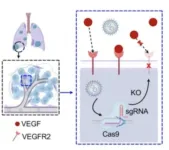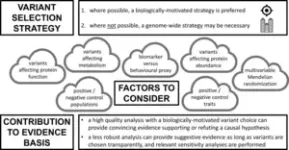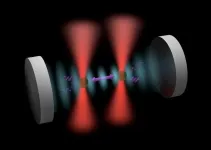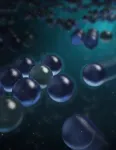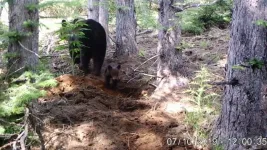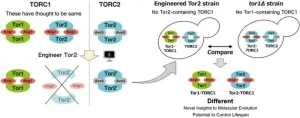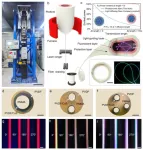(Press-News.org) Penn Engineers have developed a new means of targeting the lungs with lipid nanoparticles (LNPs), the miniscule capsules used by the Moderna and Pfizer-BioNTech COVID-19 vaccines to deliver mRNA, opening the door to novel treatments for pulmonary diseases like cystic fibrosis.
In a paper in Nature Communications, Michael J. Mitchell, Associate Professor in the Department of Bioengineering, demonstrates a new method for efficiently determining which LNPs are likely to bind to the lungs, rather than the liver. “The way the liver is designed,” says Mitchell, “LNPs tend to filter into hepatic cells, and struggle to arrive anywhere else. Being able to target the lungs is potentially life-changing for someone with lung cancer or cystic fibrosis.”
Previous studies have shown that cationic lipids — lipids that are positively charged — are more likely to successfully deliver their contents to lung tissue. “However, the commercial cationic lipids are usually highly positively charged and toxic,” says Lulu Xue, a postdoctoral fellow in the Mitchell Lab and the paper’s first author. Since cell membranes are negatively charged, lipids with too strong a positive charge can literally rip apart target cells.
Typically, it would require hundreds of mice to individually test the members of a “library” of LNPs — chemical variants with different structures and properties — to find one with a low charge that has a higher likelihood of delivering a medicinal payload to the lungs.
Instead, Xue, Mitchell and their collaborators used what is known as “barcoded DNA” (b-DNA) to tag each LNP with a unique strand of genetic material, so that they could inject a pool of LNPs into just a handful of animal models. Then, once the LNPs had propagated to different organs, the b-DNA could be scanned, like an item at the supermarket, to determine which LNPs wound up in the lungs.
After identifying an LNP that successfully penetrated lung cells, Xue, Mitchell and their collaborators administered the molecule to mice suffering from lung cancer: the treatment had a pronounced and positive effect, drastically reducing tumor size by delivering a strand of mRNA and gRNA that suppresses the growth of lung tumors. “This technology will help to accelerate the development of mRNA therapeutics beyond the liver,” says Xue, pointing to the speed, low cost and efficacy of the technique.
This study was conducted at the University of Pennsylvania School of Engineering and Applied science and supported by a US National Institutes of Health (NIH) Director’s New Innovator Award (DP2 TR002776), a Burroughs Wellcome Fund Career Award at the Scientific Interface (CASI), a US National Science Foundation CAREER Award (CBET-2145491) and an American Cancer Society Research Scholar Grant (RSG-22-122-01-ET).
Other co-authors include Alex G. Hamilton, Rakan El-Mayta, Xuexiang Han, Ningqiang Gong, Junchao Xu, Christian G. Figueroa-Espada, Sarah J. Shepherd and Alvin J. Mukalel of Penn Engineering; Gan Zhao, Zebin Xiao and Andrew E. Vaughan of Penn Vet; Xinhong Xiong and Jiaxi Cui of Yangtze Delta Region Institute (Huzhou); Karin Wang of Temple University; and Mohamed-Gabriel Alameh and Drew Weissman of the Perelman School of Medicine at Penn.
END
Precision pulmonary medicine: Penn engineers target lung disease with lipid nanoparticles
2024-03-01
ELSE PRESS RELEASES FROM THIS DATE:
Scientists make nanoparticles dance to unravel quantum limits
2024-03-01
The question of where the boundary between classical and quantum physics lies is one of the longest-standing pursuits of modern scientific research and in new research published today, scientists demonstrate a novel platform that could help us find an answer.
The laws of quantum physics govern the behaviour of particles at miniscule scales, leading to phenomena such as quantum entanglement, where the properties of entangled particles become inextricably linked in ways that cannot be explained by classical physics.
Research in quantum physics ...
Study identifies multi-organ response to seven days without food
2024-03-01
New findings reveal that the body undergoes significant, systematic changes across multiple organs during prolonged periods of fasting. The results demonstrate evidence of health benefits beyond weight loss, but also show that any potentially health-altering changes appear to occur only after three days without food.
The study, published today in Nature Metabolism, advances our understanding of what’s happening across the body after prolonged periods without food.
By identifying the potential health benefits from fasting ...
New microbiome insights could help boost immunotherapy for a range of rare cancers
2024-03-01
The microbiome can identify those who benefit from combination immunotherapy across multiple different cancers, including rare gynaecological cancers, biliary tract cancers and melanoma.
Researchers from the Wellcome Sanger Institute, the Olivia Newton-John Cancer Research Institute in Australia, and collaborators, have identified specific strains of bacteria that are linked with a positive response to combination immunotherapy in the largest study of its kind.
The study, published today (1 March) in Nature Medicine, details a signature collection of microorganisms in an individual’s gut bacteria that may help identify those who would benefit from combination immunotherapy and ...
It’s not only opposites that attract – new study shows like-charged particles can come together
2024-03-01
A study published today in Nature Nanotechnology shows that similarly charged particles can sometimes attract, rather than repel.
The team found that like-charged particles suspended in liquids can attract one another at long-range, depending on the solvent and the sign of the charge.
The study has immediate implications for processes that involve interactions in solution across various length-scales, including self-assembly, crystallisation, and phase separation.
‘Opposites charges attract; like charges repel’ is a fundamental principle of basic physics. But a new study from Oxford University, published today in Nature Nanotechnology, has demonstrated that similarly ...
Japanese wolves are most closely related to dogs and share DNA with East Eurasian dogs
2024-03-01
In this study, we determined nine genomes of Japanese wolves and 11 genomes of modern Japanese dogs at high coverage and analyzed with one hundred dog and wolf genomes in the public database. The analyses showed that 1) the Japanese wolf was a unique subspecies of the gray wolf that is genetically distinct from both extant and ancient gray wolves known to date, 2) the Japanese wolf is most closely related to the monophyletic group of dogs. Furthermore, 3) Japanese wolf ancestry has introgressed into the ancestor of East Eurasian dogs at an early stage of the dog’s history ...
Brown bears digging up artificial forests
2024-03-01
Brown bears foraging for food in the Shiretoko Peninsula of Hokkaido, Japan, have been disrupting tree growth in artificial conifer forests, according to a new study. Researchers compared soil and tree samples from human-forested plots with samples from natural forests. They found that the bears’ digging for cicada nymphs damaged tree roots and altered the nitrogen content of the soil, which in turn limited the diameter growth of trees. The phenomena of bears digging for cicadas, an unusual food source, appears to be restricted to human-planted conifer forest; diversely vegetated natural forest ...
Innovative domain-adaptive method enables 3D face reconstruction from single depth images
2024-03-01
Reconstructing a 3D face from visuals is crucial for digital face modeling and manipulation. Traditional methods predominantly depend on RGB images, which are susceptible to lighting variations and offer only 2D information. In contrast, depth images, resistant to lighting changes, directly capture 3D data, offering a potential solution for robust reconstructions. Recent studies have turned to deep learning for more robust reconstruction from depth data; however, the scarcity of real depth images with accurate 3D facial labels has hindered the training process. Attempts to use auto-synthesized data for training have met limitations ...
Groundbreaking study unveils unique roles of yeast protein complexes in cellular lifespan and environmental response by rationally engineering based on the predicted three-dimensional structures
2024-03-01
Assistant Professor Takahiro Kosugi of Institute for Molecular Science, assistant Professor Yoshiaki Kamada at National Institute for Basic Biology, and colleagues have developed an advanced molecular cell biology approach by integrating computational redesigning of protein complexes based on the predicted three-dimensional structure into yeast genetics. They revealed that two types of protein complexes in yeast, which were thought to have the same function, play distinct roles in cellular environmental response and lifespan. Furthermore, ...
Mass-produced, commercial promising multicolored photochromic fiber
2024-03-01
Fiber, as the wearable material with the longest application in the history of humankind, is currently an ideal substrate for wearable devices due to its excellent breathability, flexibility, and ability to adapt perfectly to the 3D irregular shape of the human body. As a means of visualization in the field of functional fibers, light-emitting fiber breaks the rigidity of the traditional display interface and is expected to become an emerging interaction interface. The current commercial light-emitting fibers are polymer optical fibers and Corning® Fibrance® light-diffusing fibers. These fibers ...
General Medical Council urged to revise terminology for international medical graduates
2024-03-01
The General Medical Council (GMC) should revise its terminology regarding international medical graduates (IMGs) in the UK, argues a new commentary published in the Journal of the Royal Society of Medicine (JRSM).
The existing terminology used by the GMC fails to encompass the full spectrum of doctors facing challenges in the UK medical workforce, according to the paper’s author, Professor Mo Al-Haddad of Queen Elizabeth University Hospital, Glasgow.
Notably, he says, the GMC's definition of IMGs overlooks ...
